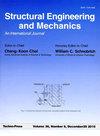高层约束屈曲支撑钢-混凝土组合框架在风致疲劳下的寿命抗震性能评价
IF 3
4区 工程技术
Q2 ENGINEERING, CIVIL
引用次数: 1
摘要
在地震、风等多重灾害的严峻环境下,工程结构由于长期受风荷载作用而产生的疲劳效应,不可避免地会使结构的全生命周期性能恶化,进一步增加结构的地震易损性。本文提出了一个考虑不同不确定性来源的结构在风致疲劳作用下的寿命抗震性能评估框架。采用该方法系统地研究了具有抗屈曲支撑的高层钢-混凝土组合框架在使用寿命期间的抗震性能。收集福建省福州市1980年1月1日—2019年3月31日的风灾现场记录资料,在此基础上,通过对比,利用Gumbel模型构建风速分布。利用OpenSees平台建立FBRB的数值模型并进行后续的数值计算。考虑风力产生和结构建模的不确定性,最终的年疲劳损伤取50组模拟的平均值。根据材料劣化模型进行修正后的时变有限元模型进行了结构寿命性能评估,包括静力推覆分析、非线性动力时程分析和脆性分析。结果表明:在疲劳作用下,结构性能随时间的推移有退化的趋势,而疲劳的影响程度随疲劳过程的持续时间和地震烈度而变化。对风致疲劳对结构响应和脆性的影响进行了明确的量化和详细的讨论。本文章由计算机程序翻译,如有差异,请以英文原文为准。
Lifetime seismic performance assessment of high-rise steel-concrete composite frame with buckling-restrained braces under wind-induced fatigue
Under a severe environment of multiple hazards such as earthquakes and winds, the life-cycle performance of engineering structures may inevitably be deteriorated due to the fatigue effect caused by long-term exposure to wind loads, which would further increase the structural vulnerability to earthquakes. This paper presents a framework for evaluating the lifetime structural seismic performance under the effect of wind-induced fatigue considering different sources of uncertainties. The seismic behavior of a high-rise steel-concrete composite frame with buckling-restrained braces (FBRB) during its service life is systematically investigated using the proposed approach. Recorded field data for the wind hazard of Fuzhou, Fujian Province of China from Jan. 1, 1980 to Mar. 31, 2019 is collected, based on which the distribution of wind velocity is constructed by the Gumbel model after comparisons. The OpenSees platform is employed to establish the numerical model of the FBRB and conduct subsequent numerical computations. Allowed for the uncertainties caused by the wind generation and structural modeling, the final annual fatigue damage takes the average of 50 groups of simulations. The lifetime structural performance assessments, including static pushover analyses, nonlinear dynamic time history analyses and fragility analyses, are conducted on the time-dependent finite element (FE) models which are modified in lines with the material deterioration models. The results indicate that the structural performance tends to degrade over time under the effect of fatigue, while the influencing degree of fatigue varies with the duration time of fatigue process and seismic intensity. The impact of wind-induced fatigue on structural responses and fragilities are explicitly quantified and discussed in details.
求助全文
通过发布文献求助,成功后即可免费获取论文全文。
去求助
来源期刊

Structural Engineering and Mechanics
工程技术-工程:机械
CiteScore
3.80
自引率
18.20%
发文量
0
审稿时长
11 months
期刊介绍:
The STRUCTURAL ENGINEERING AND MECHANICS, An International Journal, aims at: providing a major publication channel for structural engineering, wider distribution at more affordable subscription rates; faster reviewing and publication for manuscripts submitted; and a broad scope for wider participation.
The main subject of the Journal is structural engineering concerned with aspects of mechanics. Areas covered by the Journal include:
- Structural Mechanics
- Design of Civil, Building and Mechanical Structures
- Structural Optimization and Controls
- Structural Safety and Reliability
- New Structural Materials and Applications
- Effects of Wind, Earthquake and Wave Loadings on Structures
- Fluid-Structure and Soil-Structure Interactions
- AI Application and Expert Systems in Structural Engineering. Submission of papers from practicing engineers is particularly encouraged.
 求助内容:
求助内容: 应助结果提醒方式:
应助结果提醒方式:


